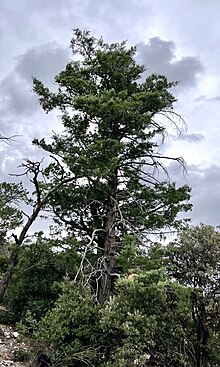|
Hesperocyparis arizonica
Hesperocyparis arizonica, the Arizona cypress, is a North American species of tree in the cypress family Cupressaceae, native to the southwestern United States and Mexico. Populations may be scattered rather than in large, dense stands. Description Hesperocyparis arizonica is a coniferous evergreen tree with a conic to ovoid-conic crown. It grows to heights of 10–25 m (33–82 ft), and its trunk diameter reaches 55 cm (22 in). The foliage grows in dense sprays, varying from dull gray-green to bright glaucous blue-green. The leaves are scale-like, 2–5 mm long, and produced on rounded (not flattened) shoots. The seed cones are globose to oblong, 15–33 mm long, with 6 or 8 (rarely 4 or 10) scales, green at first, maturing gray or gray-brown about 20–24 months after pollination. The cones remain closed for many years, only opening after the bearing branch is killed (in a wildfire or otherwise), allowing the seeds to colonize the bare ground exposed by the fire. The male cones are 3–5 mm long, and release pollen in February–March.[4] TaxonomyHesperocyparis arizonica was given its first scientific name and described by Edward Lee Greene in 1882 as Cupressus arizonica, placing it in genus Cupressus.[3][5] This description was soon after disputed by Maxwell T. Masters who, in 1896, published a journal article where he said it should be considered a subspecies of Cupressus benthamii with the variety name of arizonica.[3] A similar classification reducing it to a subspecies as Cupressus lusitanica subsp. arizonica was posthumously published by René Maire in 1952.[3] There also have been publications that suggested moving it as a species to a different genus such as Callitropsis in 2006 and a new genus, Neocupressus, in 2009.[3] As of 2024 Plants of the World Online (POWO), World Flora Online (WFO), and the USDA Natural Resources Conservation Service PLANTS database (PLANTS) list H. arizonica as the correct species name.[3][6][7] This classification was published by Jim A. Bartel in 2009.[3] However, Cupressus continues to be used in professional papers by some scientists.[8][9] Other disagreements have been over the validity of various subspecies of H. arizonica. A total of eleven have been validly published. However seven of these are listed as synonyms by POWO and WFO as of 2024.[3][6] The remaining four are listed as separate species:
DistributionHesperocyparis arizonica is found mainly in northern Mexico in the states of Chihuahua, Coahuila, Durango, Tamaulipas, and Zacatecas. It is also found in small areas of the southwestern United States in the southern parts of Arizona, New Mexico, and Texas. In the US it is found between 1000 and 1500 meters in elevation while in Mexico it reaches as high as 2200 meters in some forests.[14][3] In the wild, the species is often found in small, scattered populations, not necessarily in large forests. An example occurrence is within the Sierra Juárez and San Pedro Mártir pine–oak forests of Mexico,[15] where it is found along with canyon live oak and California fan palm. UsesArizona cypress is widely cultivated as an ornamental tree. Unlike Monterey cypress, it has proved highly resistant to cypress canker, caused by the fungus Seiridium cardinale, and growth is reliable where this disease is prevalent. The cultivar 'Pyramidalis'[16] has gained the Royal Horticultural Society's Award of Garden Merit (confirmed 2017).[17] Example of neoendemism and conservation challengesThe ease of hybridization of western cypress species in the American southwest has fostered a parallel history of taxonomic disagreements of where genus and species distinctions should apply. [18] It thus provides a case study of neoendemism in conifers. Close taxonomic relatedness, in turn, offers both challenges and opportunities if and when assisted migration is considered as a mode of climate adaptation to prevent extinctions of endemic cypresses in the American southwest.[19] References
Further reading
External linksWikimedia Commons has media related to Cupressus arizonica.
|
||||||||||||||||||||||||||||||||||||||||||||



